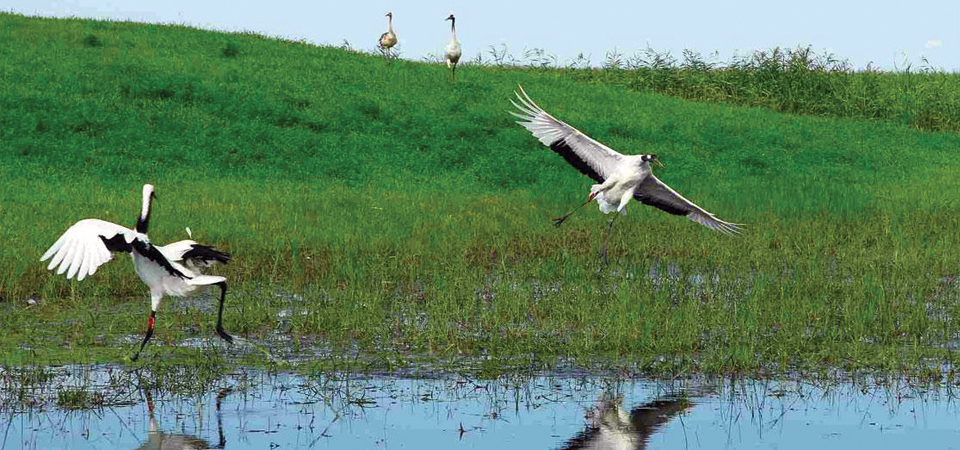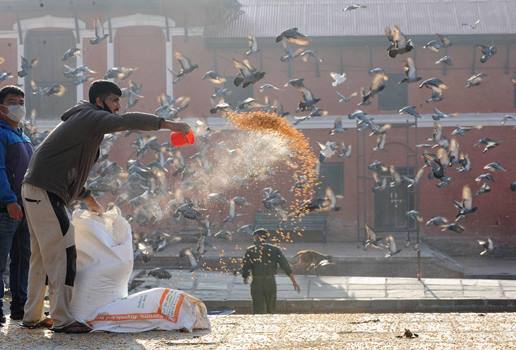Number of winter migratory birds declining

By Binu Shrestha
Kathmandu, Dec. 15: Around 150 species of winter migratory birds have arrived in Nepal to avoid extreme winter cold in the Northern hemisphere.
As per the trend of arriving winter migratory birds, this is the time when approximately 150 species of birds arrive in Nepal, said Dr. Hem Sagar Baral, an ornithologist.
Winter migratory birds started arriving in the jungles, grasslands and wetlands of Nepal from August/September to spend winter. The migration continues until January.
The arriving trend of migratory birds has gradually declined since the 1980s-90s. The number of migratory birds is declining and some species of migrant birds have stopped coming, he said.
“We have good monitoring of migratory birds and local birds in wetland areas but in other parts, mostly in Himalayan region, the monitoring is weak. Of the 150 migratory birds, around 10 winter migratory bird species stay in the Himalayan region," he added. "The previous counting shows the number of local birds is not satisfactory which determines the increasing and decreasing trend of bird population.”
Ornithologist Baral said that the number of migratory birds is falling globally. The destruction of bird habitat, hunting, water, air and other pollution and climate change are the major challenges facing the migrant birds.
Most of Nepal’s winter migrants come from Siberian region of Russia, China, Mongolia, Korea and Central Asia. These guest birds are found in jungles, grasslands, river banks and several wetlands.
Duck species like mallard, ruddy shelduck, gadwall, Eurasian teal, green shank, thrushes, fly catcher, booted eagle and other migratory bird species come to Nepal in winter season.
Grey headed lapwing, common teal, Eurasian wigeon duck species can be sighted at Taudaha and Bagmati corridor along Chovar till mid-winter.
Two kinds of migratory birds arrive in Nepal --- wetland birds and terrestrial birds.
The terrestrial birds are divided into forest birds and grassland birds. Duck species live in wetlands so their number can be easily counted.
But terrestrial birds which live in the forest cannot be counted. That’s why population of forest birds is estimated to be higher than the wetland birds, Baral said.
Half of the winter migratory birds are dependent on wetlands while the rest prefer forests and open habitats.
Jagdishpur reservoir in Kapilvastu, Ghodaghodi Lake in Kailali, Koshi Tappu Wildlife Reserve, Karnali, Narayani and Koshi River areas, among others, now see the migratory birds.
Baral said Taudaha and Bagmati River bank of Chovar are suitable sites to observe migratory duck species of winter season for the Kathmandu Valley people. But the number of migratory birds here is declining sharply due to rapid urbanistaion near the wetland areas.
He said that the national count of aquatic birds under his leadership in major wetlands will begin from January 1 to January 16 next year.
The aquatic birds counting event, which has been organised since 1987, will be held in over 50 wetland sites surveying the birds by mobilising over 300 volunteers across the country.
Nepal’s federal law has protected all birds in wildlife conservation. Total 888 species of birds have been recorded in Nepal. Of them, 168 bird species are nationally threatened. Nine species of bird receive the highest protection under the wildlife, he informed.
Birds like Lophophorus, Munal, Cheer, Black and White Storks, Bengal and Lesser Florican, Saarus Crane and great horn bill are highly protected bird species.
Recent News

Do not make expressions casting dout on election: EC
14 Apr, 2022
CM Bhatta says may New Year 2079 BS inspire positive thinking
14 Apr, 2022
Three new cases, 44 recoveries in 24 hours
14 Apr, 2022
689 climbers of 84 teams so far acquire permits for climbing various peaks this spring season
14 Apr, 2022
How the rising cost of living crisis is impacting Nepal
14 Apr, 2022
US military confirms an interstellar meteor collided with Earth
14 Apr, 2022
Valneva Covid vaccine approved for use in UK
14 Apr, 2022
Chair Prachanda highlights need of unity among Maoist, Communist forces
14 Apr, 2022
Ranbir Kapoor and Alia Bhatt: Bollywood toasts star couple on wedding
14 Apr, 2022
President Bhandari confers decorations (Photo Feature)
14 Apr, 2022









